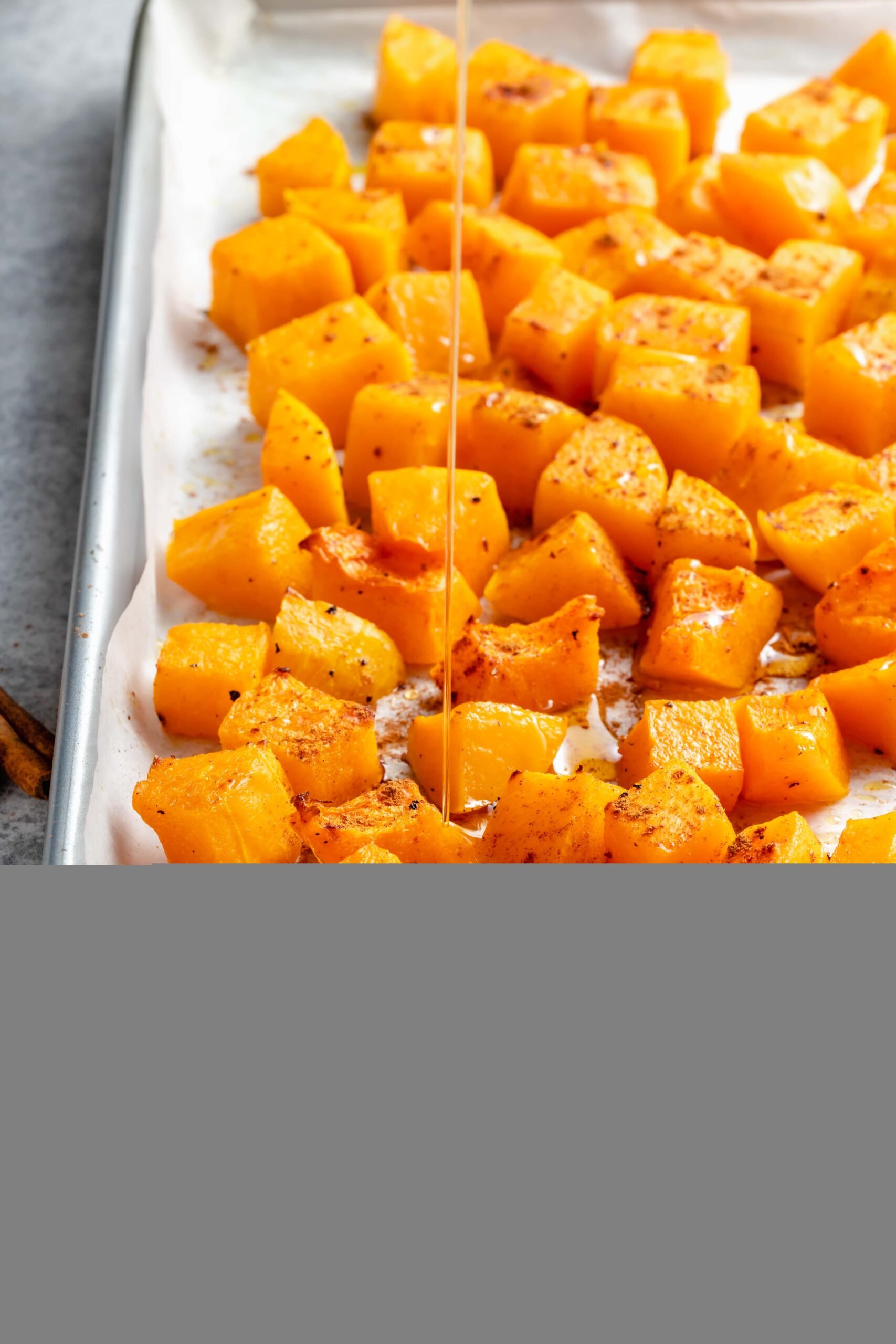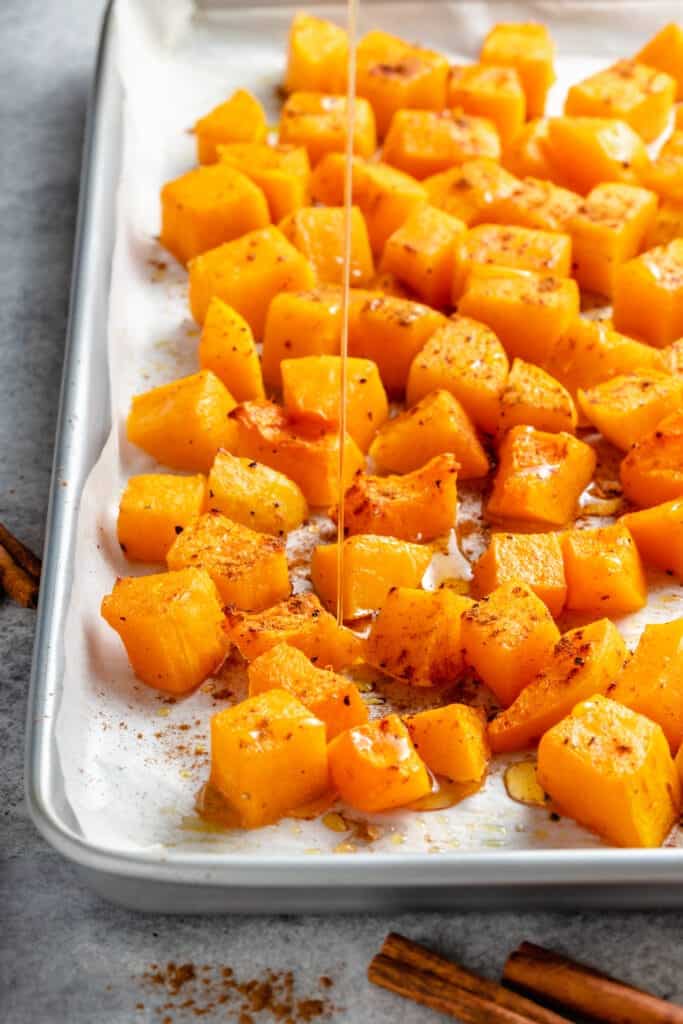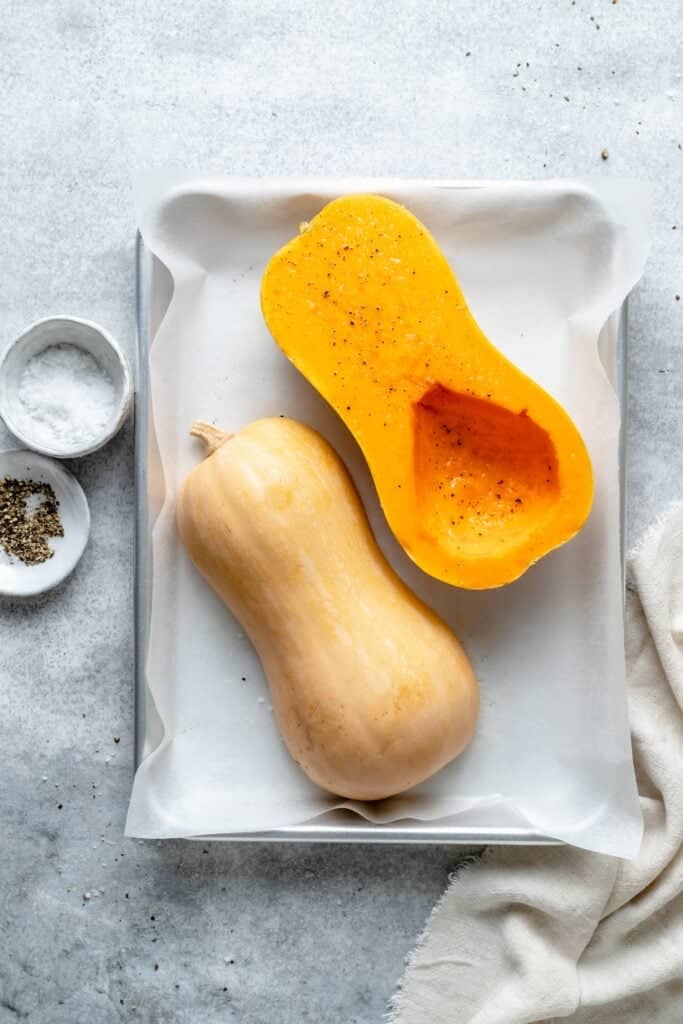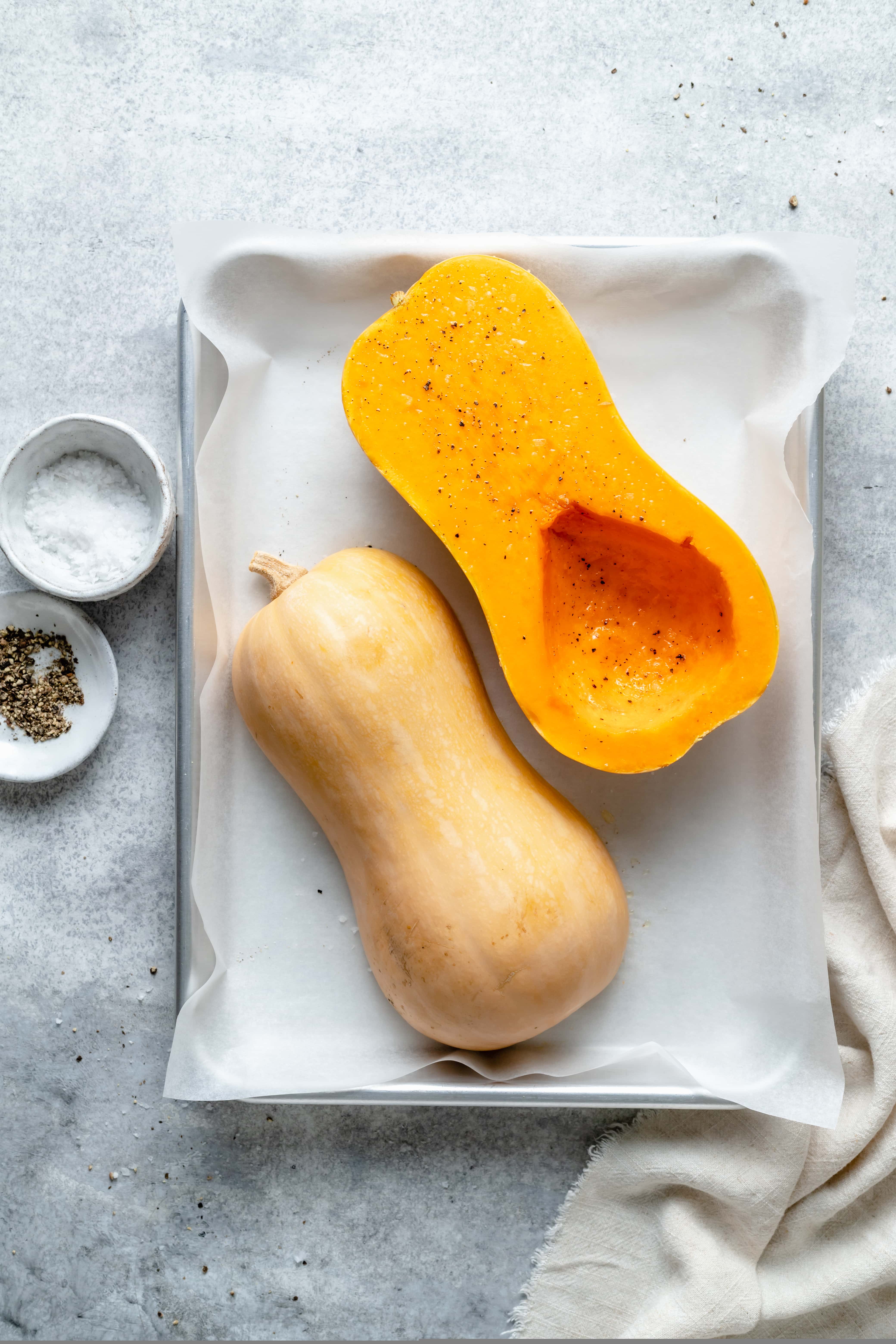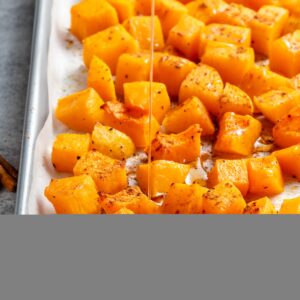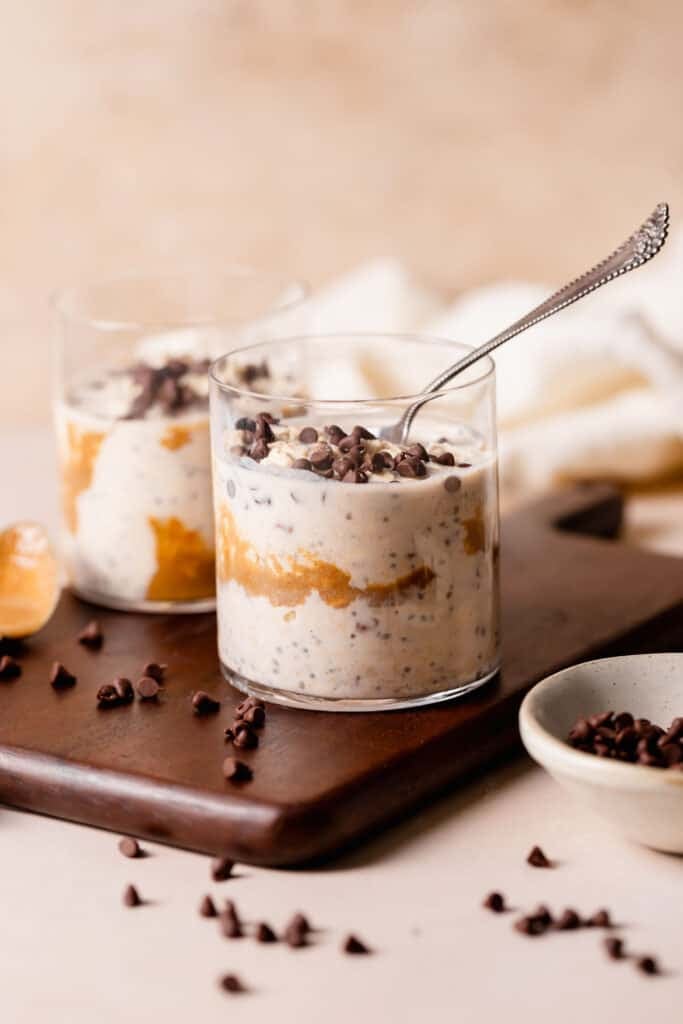If you have ever wondered how to roast butternut squash this simple guide covers everything you need to know. Roasted butternut squash is so easy to make and such a flavorful way to prepare this versatile winter squash.
I am so excited to bring you another post in our All the Healthy Things “Just the Basics” series. These posts are focused on helping you master basics in the kitchen and, hopefully, inspiring you with a few new ideas along the way.
If you are new to cooking, or just need a refresher on the basics, these posts are designed to help you feel more confident in the kitchen. Once you have a handle on a few basic concepts and techniques, you can easily build upon them to create new and exciting recipes dishes without a second thought.
If you have ever wondered how some people just seem to know how to cook without a recipe or can quickly throw together a meal in a moment’s notice, it’s likely because they have a good grasp of the basics. I want that for you! It’s my hope that every just the basics post helps you feel more comfortable so that you can enjoy your time spent in the kitchen even more!
If you haven’t already be sure to check out the other how-to guides in the series.
Here are a few of our most popular posts:
- How to Make Cream Cheese Frosting
- How to Make Homemade Pumpkin Puree
- How to Make Cashew Milk
- How to Make Homemade Tzatziki Sauce
- How to Make Easy Quick Pickled Onions
- How to Bake Sweet Sweet Potatoes
- How to Make Oat Flour
- How to Brown Butter
Why Roasting is the Best Way to Prepare Butternut Squash
- It’s easy! Once you know how to do it, roasting butternut squash is just as easy as roasting any other vegetable and once you put it in the oven there is no need for anymore hands on cooking time.
- It’s delicious! Roasting butternut squash really helps develop this rich, toasty, delicious flavor that you just cannot get any other way.
- It’s versatile! Once you have roasted the squash you can add it to soups, salads, make puree or just eat it as is!
Watch How to Make This Recipe
Roasted Butternut Squash Ingredients
Butternut Squash: you want to choose a butternut squash with an even beige or light orange color. If there are any green spots then the squash is not ripe yet. The squash should feel firm and heavy in your hand. The skin should be smooth and not wrinkly and there should not be any deep cuts or punctures in the skin. A few light scratches on the surface of the squash is totally normal!
Oil: my preferred oil to use when roasting butternut squash is olive oil has it has a relatively light flavor. You can also use ghee, avocado oil, or coconut oil.
Salt: there are several different seasoning options you can choose from (we’ll discuss more below!) but I always season the squash with a little salt to really amplify the flavor.
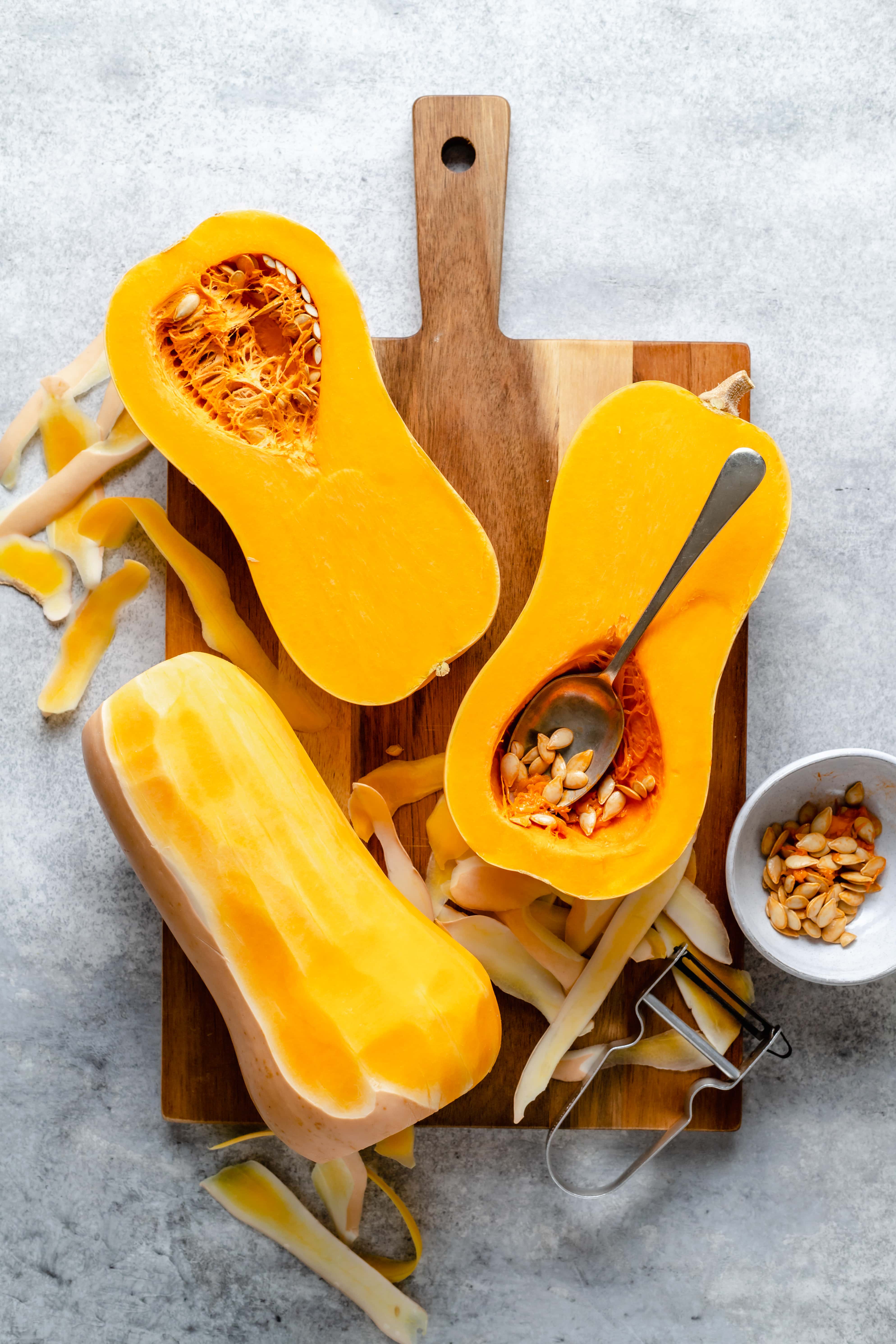
Kitchen Tools You’ll Need
Best Way to Cut, Peel, and Prep Butternut Squash
- Peel: The first step when preparing butternut squash, if roasting cubes, is to remove outer skin. A good vegetable peeler makes peeling the squash a breeze. When peeling butternut squash, be sure to continue to peel until you see the bright orange flesh underneath the skin of the squash. It may take a few passes with the vegetable peeler, but be sure to get off all of the skin and any remaining white rind.
- Slice: Use a sharp knife to slice the butternut squash in half lengthwise.
- Remove the Seeds: Once the squash is halved, you can easily use a large spoon to remove any of the inner seeds.
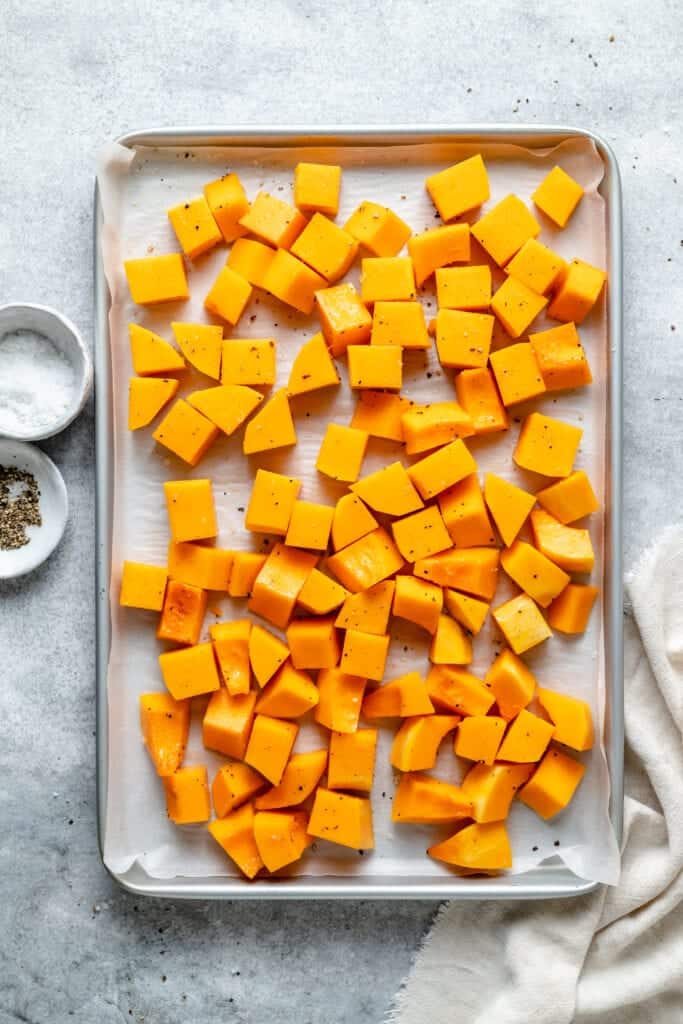
How to Roast Cubes
The first option we’re talking about for roasting butternut squash may be what you are most used to seeing, roasted butternut squash cubes!
Step One: Start by preheating your oven to 425 degrees and lining a large baking sheet with parchment paper.
Step Two: Next, use the methods outlined above to peel the skin and remove the seeds from your butternut squash. Then use a sharp knife to dice into one-inch cubes. Toss the squash cubes in olive oil, salt, any other seasonings until well coated.
Step Three: Turn the squash out onto the single layer on the prepared baking sheet. Be sure that all of the squash is in a single layer on the sheet pan and not touching, if possible.
Step Four: Bake the squash at 425 degrees for twenty-five to thirty minutes until the inside is tender and the outside edges are golden brown.
Seasoning Ideas
There are so many seasoning options when it comes to butternut squash but here are a few of my favorite options to toss your squash in!
- maple: maple syrup and ground cinnamon
- smoky: chili powder, ground cinnamon, and sea salt
- sweet: cinnamon and honey
- savory: salt, garlic powder, onion powder, and a topping of crispy chopped bacon
- herby: fresh herbs like thyme and rosemary
How to Roast Butternut Squash Halves
The next way to roast your butternut squash is very similar to how you would roast a whole pumpkin for homemade pumpkin puree, you’ll split the squash in half and roast the halves! With this method there is no need to peel the squash which I love. You can serve these halves as a gorgeous, show-stopping side dish!
Step One: Start by preheating your oven to 400 degrees and lining a baking sheet with parchment paper.
Step Two: Use a sharp knife to slice the butternut squash in half lengthwise and then use a large spoon to remove the seeds.
Step Three: Brush the halves with olive oil and season the cut side with salt and any other seasoning of choice.
Step Four: Place the halves, cut side down, on a sheet pan lined with parchment paper.
Step Five: Bake the squash for thirty to forty-five minutes until the squash is tender and a knife can be easily inserted. When you are ready to serve, flip the squash over and season with a little flaky sea salt and chopped herbs.
Tips and Tricks
- Prep in advance! You can easily dice the butternut squash in cubes or halve the squash a day in advance.
- Make butternut squash puree! Once you have roasted the halves, you can scoop out the flesh of the butternut squash, add it to a food processor or blender, and then process or blend until it becomes a smooth puree.
- Add some flaky sea salt! Finish the butternut squash with a little flaky sea salt to take it over the edge.
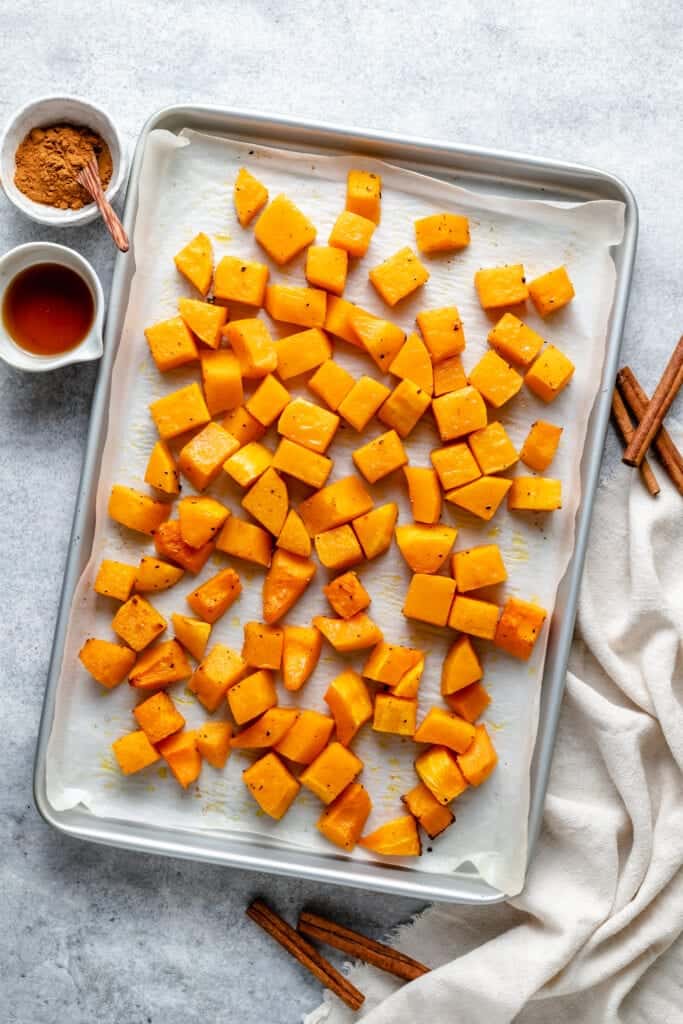
How to Store
Store your cooked butternut squash in an air-tight container in the fridge for up to four to five days.
How to Freeze and Reheat Cooked Butternut Squash
Freeze: the best way to freeze butternut squash is to freeze the puree! Once you have made butternut squash puree, you can store it in an air-tight container in the fridge for ten to twelve months.
Reheat: if you want to reheat your frozen squash cubes, you can reheat them on a parchment lined sheet pan in a 450 degree oven until heated through. If you want to reheat halves, I recommend heating them up for thirty seconds at a time in the microwave.
Ways to Use Butternut Squash
- Butternut Squash Quinoa Salad with Creamy Apple Cider Vinaigrette
- Black Bean Butternut Squash Turkey Chili
- Roasted Butternut Squash Soup
- Fall Harvest Salad with Maple Mustard Vinaigrette
- Butternut Squash Mac and Cheese
- Sheet Pan Honey Mustard Chicken Thighs
- Roasted Spatchcock Chicken

More Thanksgiving Recipes to Serve
Here are few more of our reader favorite Thanksgiving recipes to add your menu this holiday season:
- Brown Butter Mashed Sweet Potatoes
- Brussels Sprouts Au Grain
- Creamy Slow Cooker Garlic Mashed Potatoes
- Roasted Sweet Potato Salad with Honey Dijon Dressing
- Honey Mustard Roasted Brussels sprouts
- Healthy Sweet Potato Casserole
- Healthy Homemade Cranberry Sauce
- Roasted Brussels Sprouts with Bacon and Cranberries
- Brown Butter Honey Pumpkin Cornbread Muffins
I hope this tutorial has been helpful for you and that you give roasting butternut squash a try! It’s absolutely delicious and so easy to make!
If you do give this recipe a try, I want to know! Leave a comment with a star rating below. You can also snap a photo & tag @allthehealthythings on INSTAGRAM. Your reviews help support All the Healthy Things and make it possible for me to continue to create the recipes you know and love.
PrintHow to Roast Butternut Squash
- Prep Time: 10 minutes
- Cook Time: 45 minutes
- Total Time: 55 minutes
- Yield: 2 1x
- Category: Sides
- Method: Oven
- Cuisine: American
- Diet: Gluten Free
- Prep Time: 10 minutes
- Cook Time: 45 minutes
- Total Time: 55 minutes
- Yield: 2 1x
- Category: Sides
- Method: Oven
- Cuisine: American
- Diet: Gluten Free
Ingredients
- 1 medium to large butternut squash, cut into 1 inch cubes
- 1 tablespoon olive oil
- salt, to taste
Method
To Roast Cubes:
- Preheat oven to 425 degrees.
- Peel and remove the seeds from your butternut squash and then dice into 1 inch chunks. Toss the squash in olive oil, salt, any other preferred seasonings until well coated.
- Place the squash in a single layer on a baking sheet lined with parchment paper. Bake at 425 degrees for 25-30 minutes or until tender.
To Roast Halves:
- Preheat oven to 400 degrees.
- Slice the butternut squash in half lengthwise and remove the seeds.
- Brush the halves with olive oil and season the cut side with salt and any other seasonings you would like to use.
- Place the halves, cut side down, on a sheet pan lined with parchment paper.
- Bake for 30 to 45 minutes until the squash is tender and a knife can be easily inserted.
